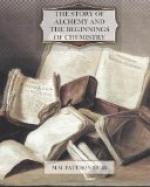But in the 17th century, and throughout most of the 18th, only a few of those who examined changes in the properties of substances paid heed to changes of weight; they had not realised the importance of the property of mass, as measured by weight. The convinced upholder of the phlogistic theory had two answers to the argument, that, because the earth-like product of the calcination of a metal weighs more than the metal itself, therefore the metal cannot have lost something in the process; for, if one portion of what is taken away weighs more than the metal from which it has been separated, it is evident that the weight of the two portions into which the metal is said to have been divided must be considerably greater than the weight of the undivided metal. The upholders of the theory sometimes met the argument by saying, “Of course the calx weighs more than the metal, because phlogiston tends to lighten a body which contains it; and therefore the body weighs more after it has lost phlogiston than it did when the phlogiston formed part of it;” sometimes, and more often, their answer was—“loss or gain of weight is an accident, the essential thing is change of qualities.”
If the argument against the separation of a metal into two constituents, by calcination, were answered to-day as it was answered by the upholders of the phlogistic theory, in the middle of the 18th century, the answers would justly be considered inconsequent and ridiculous. But it does not follow that the statements were either far-fetched or absurd at the time they were made. They were expressed in the phraseology of the time; a phraseology, it is true, sadly lacking in consistency, clearness, and appropriateness, but the only language then available for the description of such changes as those which happen when metals are calcined. One might suppose that it must always have sounded ridiculous to say that the weight of a thing can be decreased by adding something to it, that part of a thing weighs more than the whole of it. But the absurdity disappears if it can be admitted that mass, which is measured by weight, may be a property like colour, or taste, or smell; for the colour, taste, or smell of a thing may certainly be made less by adding something else, and the colour, taste, or smell of a thing may also be increased by adding something else. If we did not know that what we call quantity of substance is measured by the property named mass, we might very well accept the proposition that the entrance of phlogiston into a substance decreases the quantity, hence the mass, and, therefore, the weight, of the substance.
Although Stahl and his followers were emerging from the trammels of alchemy, they were still bound by many of the conceptions of that scheme of nature. We have learned, in previous chapters, that the central idea of alchemy was expressed in the saying: “Matter must be deprived of its properties in order to draw out its soul.” The properties of substances are everything to the modern chemist—indeed, such words as iron, copper, water, and gold are to him merely convenient expressions for certain definable groups of properties—but the phlogisteans regarded the properties of things, including mass, as of secondary importance; they were still trying to get beneath the properties of a thing, to its hypothetical essence, or substance.




